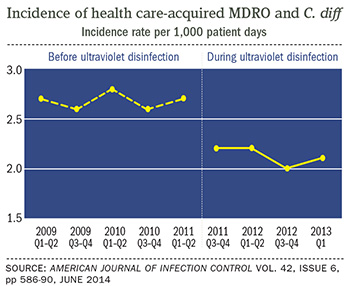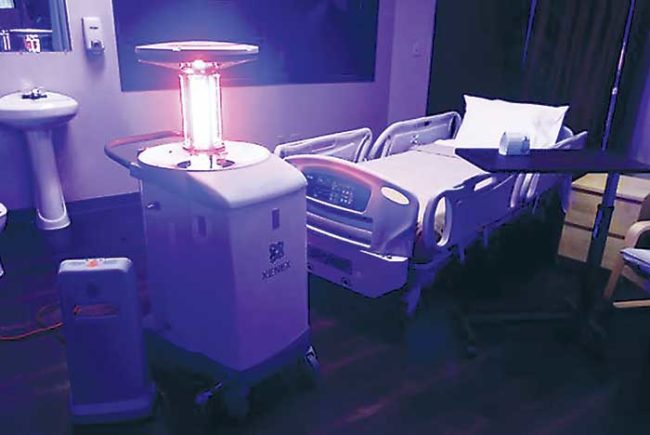 |
|
The graph shows the positive impact ultraviolet disinfection had on the rate of multidrug-resistant organisms and Clostridium difficile in patient rooms at Westchester Medical Center, Valhalla N.Y. |
Adding ultraviolet environmental disinfection (UVD) to the cleaning regimen of patient rooms at Westchester Medical Center, Valhalla, N.Y., was associated with a 20 percent reduction in health care-associated, multidrug-resistant organisms (MDROs) and Clostridium difficile.
During a 22-month period in which UVD was used, the rate of hospital-associated MDROs and C. difficile dropped compared with a 30-month period without UVD, according to a report in the American Journal of Infection Control.
Health care-acquired vancomycin-resistant enterococci (VRE), methicillin-resistant Staphylococcus aureus (MRSA) and C. difficile were among other MDROs that were reduced during the project. Rates dropped to 2.14 cases per 1,000 patient days compared with 2.67, the study shows.
During the 30-month period of the study before UVD was implemented, the hospital used standard cleaning protocols such as bleach to disinfect MDRO-patient rooms upon discharge. The hospital leased two pulsed ultraviolet disinfection machines and used them as part of a discharge cleaning regimen for rooms housing patients with MDROs and C. difficile for 22 months of the study.
The pulsed UVD machines required positioning for six minutes each in the patient bathroom and two other locations within the bedroom for an 18-minute cycle. Machine arrival and setup time added a total of 51 minutes per discharge, says Janet Haas, R.N., director, department of infection prevention and control, Westchester Medical Center, and lead author of the study.
She says the 15- to 18-minute cycle for the pulsed UV made it much more feasible to use than other environmental disinfection processes.
Authors of the study say that the rates experienced during the use of UVD are the lowest rates of VRE at its institution for the past 10 years and were sustained for 22 months.
Studies on the impact of UVD as part of a patient room cleaning regimen mostly have covered the efficacy of killing bacteria on test plates in various locations in patient rooms, Haas says. The study recently published in AJIC is among more distinctive research for focusing on patient outcomes related to UV technology.
"We are not the first, but we are among the first to report on patient outcomes being positively impacted by the use of UVD, and particularly pulsed UVD which is newer technology than the mercury device," Haas says.
The UVD was associated with a dramatic decline in health care-acquired MDROs and C. difficile despite the fact that 24 percent of the opportunities to use the technology were missed because staff to run the machines were not available at all times, Haas says. Having dedicated staff to operate the devices might reduce HAIs even further, she notes.





